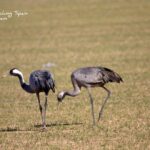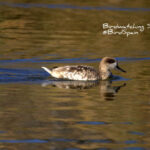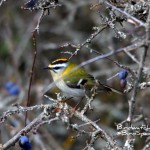Birdwatching and wildlife tours in Spain
Bird watching La Mancha
I hope you find useful our Bird watching La Mancha and Serrania de Cuenca trip report in November. Our recent trip has been a complete success. This itinerary around La Mancha and Serranía de Cuenca is flexible, and it is designed to offer different alternatives depending on the clients’ preferences. Not only the area offers an incredible variety of birds, but also butterflies, orchids and an important cultural background.
Day 1 Bird Watching La Mancha

It has been an unusual dry autumn in East Spain and many temporary lagoons are dry in La Mancha, but no Manjavacas where we start our bird watching and nature tour in La Mancha. It is late afternoon and we are welcomed by Marsh Harriers and Meadow Pipits. In the middle of the lagoon there is a large number of Mallards, Shovelers, Shelduck and Teals. As we continue driving around the lagoon, Zitting Cisticola flies off the reeds. In addition, Dunlins and Little Stints feed intensively in the shore.
The background sound of Common Cranes, reminds us the importance of La Mancha as a wintering area for this superb birds.
We continue driving until the last viewing point where we observe Song Thrush, Crested Lark and 250+ Cranes.
Day 2 Bird Watching La Mancha (Tablas de Daimiel)
Today we will spend the day in the National Park of Tablas de Daimiel and surroundings. As we arrived, a Little Owl looks at us from a cottage in a vineyard. Ten minutes later we are lucky enough to see 5 Marbled ducks swimming close to us. What a beautiful bird!! There are very few places in Europe where this endangered bird can be seen and one of these places is Las Tablas. Regarding insects, we see Clouded Yellow, Small and Large White butterflies and Common Darter dragonflies. Along the path, we spot Little Egret, Chiffchaff, Flamingo Red-legged Partridge, Spotless Starling, and Crested Lark. Along the banks Marsh Harriers and a good number of song birds are seen.
We move to another lagoon located outside the National Park to continue our bird watching La Mancha tour. There we find Greylags, Gadwall, Black-winged Stilt, Lapwing, Cattle Egret and Reed Bunting. Water Rail and Purple Swamphen call from the reeds.
Day 3 Bird Watching La Mancha
We spend the morning in the rich farmland area of La Mancha before moving to the Serrania de Cuenca. In a few hours we are able to see large flocks of Linnet, Skylark, Rock Sparrow and Corn Bunting. As we drive to the fields we watch a pair of Little Owls and Stonechats, Kestrels, Common Buzzards, a Hoopoe and a solitary Great Bustard. Black Redstarts are possibly one of the most common birds.
Twenty minutes later, we find in a farmhouse a juvenile male Spanish Sparrow perch in a wire. Then, three Red Kites join together and 40+ Tree Sparrows hide behind the pines.
Half an hour later we are in an open oak tree forest surrounded by Thekla Larks, Sardinian Warblers, Long Tailed Tits, a Iberian Grey Shrike and Red Admiral Butterflies.
We get at dusk at the Serrania de Cuenca, with time to see the first Griffon Vultures and Red billed Choughs.
Day 4-5 Serrania de Cuenca
Our first stop is in the Uña lagoon, a beautiful mountain lagoon surrounded by stunning cliffs. Blue and Great Tit, Little Grebe, Teals, Shovelers, Grey Herons, Ravens, Great Spotted Woodpecker, Jays, Cetti’s Warbler, Jay, Black Cap, Jackdaws, Red Wings and Mistle Thrushes are seen. However, the favourite one is a kingfisher we find resting in the reeds..
Later, we continue driving up to the mountains to stop near the river where can be observed Firecrest, Rock Bunting, Dunnock, Coal, Long-tailed and Crested Tits. A group of Red Deers graze near the dam and crossbills keep flying around us.
As we search the sky for raptors, the Iberian subspecie of Green Woodpecker flies in front of us and a Yellowhammer stands from a bush.
Should you have any question, please do noy hesitate to contact us or visit the tour calendar.

